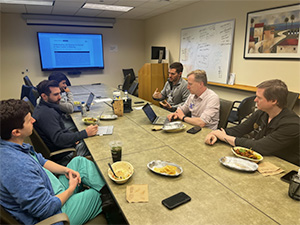Neuroradiology’s Journal Club Fills in the Gaps

The Neuroradiology Supplemental Curriculum augments the education fellows receive. This curriculum is made up of lectures, case conferences, and journal club.
The lectures feature speakers from other divisions or different departments, such as neurosurgery and neuropathology. For their case conferences, fellows bring in their most interesting cases to teach one another under the supervision of the Supplemental Curriculum Director, Dr. Chase Krumpelman. In the journal club, fellows widen their knowledge base and build community through group discussions of journal articles. Everyone reads the assigned articles, and one person guides the discussion. They take on a wide range of topics from developments in their subspecialty to health-care inequities.
The journal club was started to offer instruction in areas where there might be a gap in knowledge. When Dr. Alex Nemeth passed the responsibility of leading it to Dr. Virginia Hill in 2019, she enthusiastically began researching articles, inviting speakers and getting dates on the calendar.
The journal club is now led by Dr. Chase Krumpelman. Dr. Krumpelman says, “Fellows need to be exposed to literature, and we like to do that in a guided way. Everyone will read a journal article on a particular theme, such as a type of diagnosis or on leadership or on DEI. One person guides the discussion and covers the learning objectives and specific questions for their article.” He often prepares for the group by looking for the most popular articles in the American Journal of Neuroradiology.
Dr. Hill says, “When I began leading the journal club, the Graduate Medical Office had recently told all departments that they needed to include a Diversity, Equity and Inclusion component in their training. So, I took a day and read 26 articles on DEI and chose the four that I thought were the most helpful. The first article was on health care disparities and touched on social, economic and environmental disadvantages and barriers that keep vulnerable populations from receiving the health care they need. It gave an idea of what people go through and how important it is for us to be aware of those barriers and how to overcome them.”
The second article Dr. Hill chose focused on patient-centered medicine. “It talked about how you need to know about your patient, you need to know something about their culture and background. It made the point that you might be more valued for being kind and thinking about their overall wellbeing rather than focusing only on their chief complaint.”
Dr. Hill was impressed by the author’s including that you can’t know about every culture, but there are characteristics you can keep in mind that are common, and you can ask questions to give better care.
Dr. Hill's next article focused on transgender health care, where she learned of the statistic that 28% of transgender people postpone care even when injured or sick. Research also showed that a fifth had been refused care because of being transgender, and half had to educate their providers on transgender facts and issues. The journal club discussed how Northwestern takes the important step of showing respect by asking for the name and pronouns a patient uses and how they identify. It's important to know their history because transitioning genders impacts their care. For example, their history can provide a pretest probability for breast cancer. Hormone therapy can increase the risk of blood clots.
These facts point to the importance of neuroradiology’s supplemental curriculum. The journal club, in particular, provides information that is critical to good patient care, but that isn’t always covered by other parts of training.